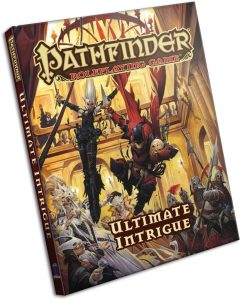 Ultimate Intrigue
Ultimate Intrigue
Published by Paizo Publishing
The latest of the Ultimate series books is packed with a ton of themed information. This is a gem for any espionage player or GM. Ultimate Intrigue features the Vigilante base class, new archetypes, feats, intrigue systems, social combat, new spells, and gear.
Vigilante base class has some pretty cool perks. The first and the coolest is the ability to have dual identities – like Batman! The class has the option for each identity to have a different alignment. My GM would have a lot of fun with that concept, and as a player it would be a great challenge to role-play. Beyond that you get to pick a path of specialization as an avenger or a stalker. An avenger gains an attack bonus equal to the character level, while a stalker capitalizes on stealth to gain 1d8 precision damage on flanked, flat-footed or otherwise unaware foes. This increases 1d8 every two levels. There are also several Vigilante talents. My favorite has to be Blind Spot. It allows the character to hide from creatures with special senses like Tremor Sense. That’s something I could have used in my last adventure.
There are of course several new archetypes in Ultimate Intrigue, and while many of them are specialized most can be used without too much difficulty. My favorite is the Guild Breaker, a Ranger who specializes in taking down an enemy organization. The difference is that the bonuses they get are applied to an enemy organization instead of to a favored enemy. This archetype also gets Deep Cover, which allows bonuses to Bluff and Disguise against the enemy organization.
The best NPC archetype has to go to the Interrogator. It’s always a good character to have on hand as a GM helps players extract some of that much needed information. I couldn’t imagine playing one though. The Interrogator uses alchemy as the base for extracting information from her victims. I would have liked to see more variants on the Interrogator, like one that leans more towards social skills or even one that is more physical – not quite a torturer.
The Ranger gets more love in Ultimate Intrigue with the introduction of three new combat styles: Deceptive, Menacing, and Underhanded. Deceptive focuses on making the most out of feint feats, while Menacing focuses on a wild display of combat capitalizing on feats like Dazzling Display and Gory Finish. Underhanded grants the Ranger the Dirty Trick feats.
This book brings us nearly 150 new feats, all of which play into the intrigue idea of this book. For example, Deft Catcher allows the feat holder to use Sleight of Hand to catch falling items. On first look you might think that this has very little to do with intrigue, but it can open the door to all kinds of role-playing opportunities. I think this is one of the more universal feats of the book as well.
Paizo also introduces seven intrigue subsystems: Influence, Heists, Leadership, Nemeses, Pursuit, Research, and Spells of Intrigue. These can give your game some new elements. Some of these systems expand rule sets that already exist. Leadership is one example of expanding current rules. This is done by finding ways to examine the followers of characters with Leadership. They look at questions like what happens if a follower shares different views, is assassinated, or if one becomes bribed. This makes me look at Leadership in a whole new way. Heists and Research are both good additions. Heist basically lets the players plan a heist thus writing the story for the GM. Research allows you to create libraries that based on their clout offer bonuses to skill checks. Some of these libraries can be studied in for hours or even days before exhausting the information.
The Pursuit rules give you a system to track an enemy over a period of time. The pursuit is broken down into sections, each represented by a terrain tile that reflects distance, the type of terrain, and any other challenges the GM might want. The idea is to have the party track the quarry until captured. There will generally be one player who is the main tracker, but any players not actively tracking can attempt to help the group’s progress by gaining an advantage or using tactics. Once the group has made enough progress, they can move to the next tile. Pursuits have always been tricky to coordinate, but I think this will make them easier.
Chapter four introduces rules for Social Conflict and Verbal Duels. Since I haven’t used the rules for Social Conflict yet all I can say is that they look like they will create some great role-playing sessions. They will also help engage the party in plot points. Verbal Duels are for players that might engage in arguing or defending a point of view or trying to pull off a bluff. If you’re already a good role-player then you might find these rules a bit unnecessary, but they could be helpful for players that struggle with speaking in character. Where this seems like it will succeed is in situations similar to lawyers arguing.
The rest of Ultimate Intrigue is filled with spells, items, and both magical and mundane gear. If you like to play spy thriller type games, or if you splash those elements into your game, then this book is full of morsels for you. Many of the new or expanded rules offered can be applied to nearly any game, while Social Conflict can make any session become packed with acting. Ultimate Intrigue has everything you need to create a great intrigue story, short of the base rules of course. Is it a must have? No, but I highly recommend this book.

















